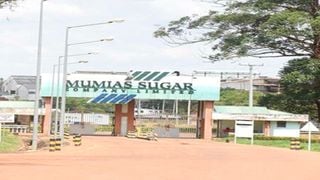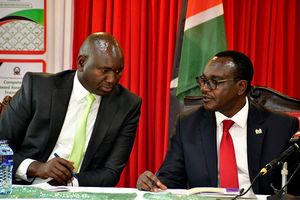
Mumias Sugar Company in Kakamega County. Our problem is that the farm acreage per family has reduced in size from the 1960s.
| File | Nation Media GroupWeekly Review
Premium
After 100 years of milling sugar, is it time to let the white elephants die?
Politicians were this week telling sugar farmers in Western Kenya that there is a future in smallholder schemes and that they should continue cultivating and delivering cane – once the struggling companies are revived.
Besides all that promise – and the threats that came with it – is the question: are we duping our farmers that there is a future in smallholder cane growing? Can we get them an alternative crop and let the sugar belt white elephants die?
Perhaps we can learn something from Sudan’s Kenana Sugar Company, which the government partly owns. Kenana, which was started in 1980, is the largest white sugar producer in the world and has transformed an entire region, employing thousands of people. Set up by Lonrho’s Roland “Tiny” Rowland, Kenana is today owned by the government of Sudan, while Kuwait and Saudi Arabia have stakes.
The reason why Kenana has succeeded is because it has identified multiple by-products from the sugar-making process. But the most important is that it grows its cane within the synchronised 100,000-acre farm. That way, it offers quality jobs and better returns to the country.
Kenana is now competing with large producers such as Brazil, for besides raw and white sugar, it is also producing first and second-generation ethanol, bio-fertilisers, animal feed, bio-fuels, yeast, and plastic in separate factories. There was so much money in the sugar industry that Kenana was building a port terminal in Port Sudan and opening two major Sugar projects (if not disrupted by the war). Sudan has been a major player in the $44.71 billion sugarcane syrup market.
In Kenya, what we call the “revival of the sugar sector” follows the age-old tradition of “writing off debts” and getting newcomers to make sense of smallholder schemes. As a result, they manage to keep smallholder sugarcane farmers busy waiting for the transformation of the sector. The complexity of managing smallholder cane farmers was seen very early.
The August 5, 1971 warning by Commonwealth Development Corporation sugar consultant B.C.J. Warnes still echoes across the sugar belt had we listen: “The outgrower is an individual. He can’t be hired and fired even if it were politically acceptable to do so, which it is not. And yet the collective fortunes of the entire body of outgrowers, and the milling company itself, depend absolutely on the willingness and ability of each and every grower.”Mr Warnes’ letter, written to then Agriculture Deputy Secretary, Mr G. Musembi, and later sent to the Commissioner of Cooperatives, Joshua Muthama, had warned that producing enough cane — which seemed to be the sole objective of the government — was not enough for the smooth running of a sugar enterprise.
“High throughputs call for some very exact timing and co-ordination on the cane growing side… it is not sufficient to merely produce the total quantity of cane required annually. It has to be grown, harvested and delivered with almost split second timing so that exactly the right amount of cane goes on arriving at the mill round the clock, day after day and week after week,” he said. To evade this problem, the expert suggested that an organization be formed, that can have “dictatorial” powers to enforce discipline on the more than 3,000 outgrowers which he warned would be a “highly sophisticated, technical and political operation”.
Highly mechanised
It is not that there is no literature on sugar as a plantation crop or how smallholder schemes work. The government has been in the sugar business for close to 60 years now. The private sector has been in the milling business for 100 years. The problem is that the farm acreage per family has reduced in size from the 1960s, thanks to population. The yields have decreased, and the cost of production has increased.
While successful sugar plantations worldwide are highly mechanised, we still manually harvest cane in smallholder farms. There have been suggestions that farmers should do block farming to synchronise farming and enable mechanisation. But that is a radical move, and no politician wants to carry out a land revolution. And so, we can watch Zambia Sugar Plc do the miracles of producing enough sugar for the domestic market and becoming the No 45 sugar exporter in the world. It has one single estate which produces 1.9 million tonnes of cane, while the small to large-scale growers in the sugar belt supplies 1.5 million tonnes.
If you compare it with Kenya, you find that Muhoroni, now in receivership, receives 90 per cent of its cane from smallholder farms that are constantly grappling with transport problems, overgrown and poor-quality cane. The same story is repeated in Mumias, Chemelil, Sony, Nzoia, and Miwani.
In Kenya, a visit to the sugar belt is like a walk to the archives of sugar history. The government-run mills, dead at best, have no semblance of life. The private-run mills with some level of efficiency are still in business. We have thrown away chances of having a viable sugar sector. In 1961, when the Hindocha family owned it, the Miwani Sugar Mills installed Mirrlees Watson equipment to produce refined white sugar in the country. It was the first time white sugar was produced in East Africa, and Kenya was making history in the region. The company celebrated that milestone by placing a full-page advert announcing that stage of progress.
“The manufacture of refined white sugar not only marks a big step forward in the sugar industry in Kenya but will result in saving in the foreign currency which was formerly used to import this type of sugar.” What went wrong? The Hindochas were forced out of Miwani, and the government took it over. More so, the Chemelil nuclear estate was also taken over to establish Chemelil Sugar. The rest is history. When farmers were asked to grow cane within the Chemelil belt, they did it enthusiastically — to the extent that in 1965, the military was summoned to help them harvest and deliver cane to the Miwani factory in what became known as “Operation Sugar Cane”. The army’s transport unit harvested 4,000 acres of cane within 64 kilometers. By the time they were done, under the command of Lt M.S. Garcha, they had transported more than 30,000 tonnes of cane in tortuous roads. When he purchased the former Victoria Nyanza Sugarcane Company, Indian entrepreneur Devjibhai Hindocha.
A pioneer in the sugar industry in Kenya, was hoping to build a network of sugar factories in Western Kenya and Nyanza. At first, his Miwani empire comprised of 15,000 acres of cane and a workforce of 4,200. Each year, he sold 20,000 tons of sugar. Besides Miwani estate, he expanded into Chemelil, Kibigori built trolley lines, and cane was delivered using tram trains. This network no longer works.
The pioneer sugar farmers went for the best in the world. In 1913, they imported some cane varieties from South Africa and India’s Coimbatore Research Station in Tamil Nadu. For many years, Kenyan farmers have relied on the Coimbatore varieties, which is why the Kenyan cane varieties have the prefix CO. As Independence Day approached, the sugar plantations were seen as sites of oppression, and the best that the government did was to allow the smallholders to start growing sugarcane. However, the infighting between the Ministry of Agriculture and the Ministry of Cooperatives left the sugarcane growers with no cooperative society – an experiment that was working in the coffee sector.
Chemelil was the first experiment on smallholder sugar production in Kenya and sugar cooperatives. The cooperatives were used in production chains, supplies, credit, transport, marketing, and processing. But some government officials had other ideas. Rather than fight, Commissioner of Cooperatives Joshua Kimote Muthama threw in the towel. The Mumias investors, Bookers Agricultural Holding, foresaw trouble if the farmers were not organised. In a letter they sent to the Ministry of Agriculture, Bookers’ project manager M. N. Lucie-Smith suggested that the freehold land owners need “a great deal of indoctrination” to accept the cooperatives.
The Treasury, then under Mwai Kibaki, started pushing for an outgrowers’ organisation – rather than a cooperative. The problem was that they had no idea how to organise a plantation cash crop within smallholdings. Sixty years later, we continue failing the farmers and throwing taxpayers money to revive what could be considered to be white elephants. Should the solution be to get the farmers an alternative crop and let the white elephants die?
[email protected] Twitter: @johnkamau1





